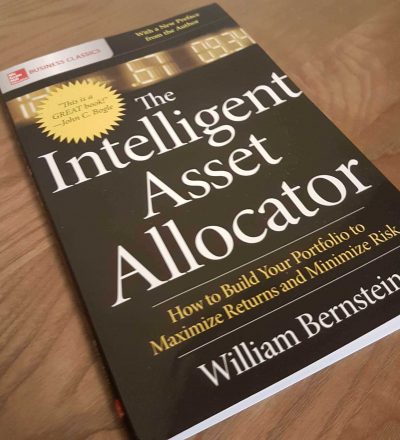The Intelligent Asset Allocator- Book Review

Premise of the book
As the title suggest, the book focuses on asset allocation and explains how you can maximize returns while minimizing risk. We’ve all heard that there is no free lunch when it comes to investing and that, higher returns must equate higher risk. In this book, William Bernstein explains how asset allocation is the one exception.
About the author
William Bernstein is a neurologist by trade but investor at heart. As a self-taught investor, Bernstein provides a relatively unique view of the investment world. His approach is based on cold hard facts and numbers, lots of numbers. As a best selling author of seven books, this one was one of its first.
Structure of the book
The book is divided in four parts:
- An introduction to the stock market – The author recaps the risk and reward matrix inherent to the investing world and provides a slew of evidence as to why stocks provide the highest returns of any asset class but why bonds should never be neglected.
- An introduction to portfolio theory – Bernstein lays the groundwork for the rest of the book and gently introduces us to the idea behind asset allocation, the benefits investors can derive from it, and why it should work.
- Portfolio theory in the real world – After introducing us to the theories behind asset allocation, William Bernstein walks us through decades of investment returns, both in the USA and abroad, and shows us that theory isn’t always aligned to the real world.
- A guide to building your own successful investment portfolio – Bernstein finishes his book with a much-needed checklist on asset allocation that can help any investor build a successful portfolio.
Key takeaways of The Intelligent Asset Allocator
The book may seem thin but it is jam-packed with content. The concepts brought forward are a must for any investor and I am frankly surprised at why so few people recommended this book. This book is a gold-mine packed with numbers, formulas, and mathematical concept. Here are my top 15 take-aways from the Intelligent Asset Allocator by William Bernstein.
The Basics
1. We own stocks to hedge long-term risk and bonds to hedge short-term risk.
2. The concept of correlation of assets is central to portfolio theory. To decrease risk, you should invest in assets that have low correlation to each other. This way, if one asset class (e.g. the S&P 500) starts to decrease, there’s a chance that the Japanese stock market may not be affected, and vice-versa. Bernstein crunched the numbers and found that the S&P 500 and US small stocks had a correlation of 77% between 1975 and 1998. In comparison, the S&P 500 had a correlation of just 48% with foreign stocks. Meanwhile Japanese stocks and US REITS had a correlation of just 6%!
3. Diversifying across asset classes can decrease risk and increase returns. This is done through rebalancing as the method would force you to move against the market by buying low and selling high.
4. The longer a risky asset is held, the safer it becomes. Yes, small stocks are riskier than large stocks but they also provides slightly better returns. Remember: short-term volatility is meaningless, what matters is long-term performance
Counterintuitive but priceless data
5. Never neglect stocks. Bernstein ran the numbers and found that a portfolio composed of 7% stocks and 93% bonds is actually SAFER than a 100% bond portfolio. In fact, you’ll need to increase your stocks allocation up to 12% to achieve the same level of risk as a portfolio of 100% bonds. Diversification and rebalancing are a powerful combo. Increasing returns while minimizing risk is entirely possible.
6. Never neglect bonds. Takeaway #5 works the other way around. Adding a little bit of bonds to a 100% stocks portfolio will reduce risk by a large amount while decreasing returns by a very small amount.
7. Avoid broken asset classes. Bernstein found that, over the long term, the 5-year treasury bond has provided very similar to the 20-year bond, yet the 5-year bond carried significantly lower volatility (6% compared to 11%). In this scenario, buying into a riskier asset does not increase performance. Always study the risk-to-reward matrix before investing.
8. Don’t buy bonds for their returns. Stocks perform much better than bonds over the long term. This means that you should only buy bonds with the aim of diluting the risk within your portfolio, and not for their interest payments. Now that we’ve settled that bonds are here to dilute risks, we should always favor safer bonds such as a US 5-year treasury note instead of the 20-year bond. Bonds are here to increase portfolio stability and help you get through bad times, don’t throw this stability away because a junk-bond offers you an extra 1%.
Portfolio theory
9. Portfolio theory isn’t about finding the “best” asset allocation. It’s about finding an allocation that will perform reasonably well under a wide range of possibilities. For this reason, portfolio theory is all about mixing asset classes which have little correlation to each other.
10. Asset classes tend to perform similarly over time. The author ran the math on page 56 of the book. Bernstein back-tested 800 different portfolio allocation across 6 asset classes over several decades to determine what is the “best” portfolio allocation. The result? Some portfolio outperform in some decades but perform horribly in others. However, the long term returns of each portfolio are surprisingly similar. As such, it is impossible to predict what is going to be the optimal asset allocation for the next decade. Nonetheless, we can still use probabilities and statistics to make an educated guess.
11. The 3 basics of portfolio theory: Nationality (US, European, Japanese, Emerging Markets), Size (small versus large-cap), and stock type (value or growth). Aim to have a varied mix of each.
12. The 3 behavioral complexity of portfolio theory to consider: Complexity, conventionality, and risk:
Complexity – Some investors like to keep things simple with just 3 asset classes, others appreciate a complex portfolio of 10 asset classes which makes the rebalancing process a lot trickier.
Conventionality – Some investors prefer a more conventional portfolio in the sense that it will track what is commonly referred to as ” the market” (i.e. the S&P 500). Diversifying away from the S&P 500 into Japanese or European small stocks may increase performance and decrease volatility over the long-term, but there may also be long periods of underperformance to the S&P 500, which may be difficult to stomach for some investors.
Risk – Some people just don’t have the stomach for higher risk, as such they should probably aim for a higher allocation to bonds. This will decrease performance but may help them sleep better at night
Portfolio management
13. Do not rebalance too frequently. Unfortunately the market isn’t always efficient and asset classes tend to keep their momentum going, even after it should have burnt-out. The best example of this is during the Japanese stock market bubble of the late 1980s: Japanese stocks were rising fast while the US stock market was dropping. Any rational investor would have started to rebalance out of the expensive Japanese stocks and bought into the cheaper US stock market, however this strategy didn’t work. The Japanese stock market kept going up for another 5 years! Bernstein advises not to rebalance more than once per year.
14. Bad companies make for good stocks and good companies make for bad stocks. This one may leave you scratching your head but the reasoning is sound: If a company isn’t doing great, it is probably ignored by investors and as such will be trading at a low P/E ratio (i.e. it will be cheap). However a great company that everyone loves (e.g. Tesla) is going to be followed by countless investors and will be trading at a high P/E ratio (i.e. it will be an expensive stock). The math checks out too: Historically “cheap” companies tended to provide better returns in the long term than ” expensive” companies.
15. Growth stocks outperform value stocks during a bull market, but value stocks lose considerably less value during a bear market. Because of that, value stocks performed better historically.
The verdict
I’ll be honest with you, this was by far the hardest book review I’ve done to date: I usually limit myself to only 10 takeaways but with the hundreds of takeaways packed in this book, I added an extra five. I am not kidding, I’ve learned more from this book than any other.
Don’t be fooled by it’s size. The Intelligent Asset Allocator by William Bernstein is crammed with valuable content. The author provides a ton of information, tested theory, and historical data to back it up. This book will teach you how to build a portfolio that can reduce risk while maximizing performance, this is possibly the only free lunch in the investment world.
This is a great book but it certainly isn’t a casual read. There’s a lot numbers, formulas, and mathematical concepts that makes it difficult to read in one sitting. The author himself concedes that this book should be read in small doses in order to absorb all of its knowledge.
In his later book, The Four Pillars of Investing, Bernstein explains that this book The Intelligent Asset Allocator was a “successful failure”. This was because, while the book did sell many copies, it appealed mostly to professionals and not to the general public. Interestingly enough, I find this book provides better argumentation and insights into portfolio theory and portfolio management than his later books.
Bottom line, if you’re looking for a serious book on how to build a successful investment portfolio, this is it.
